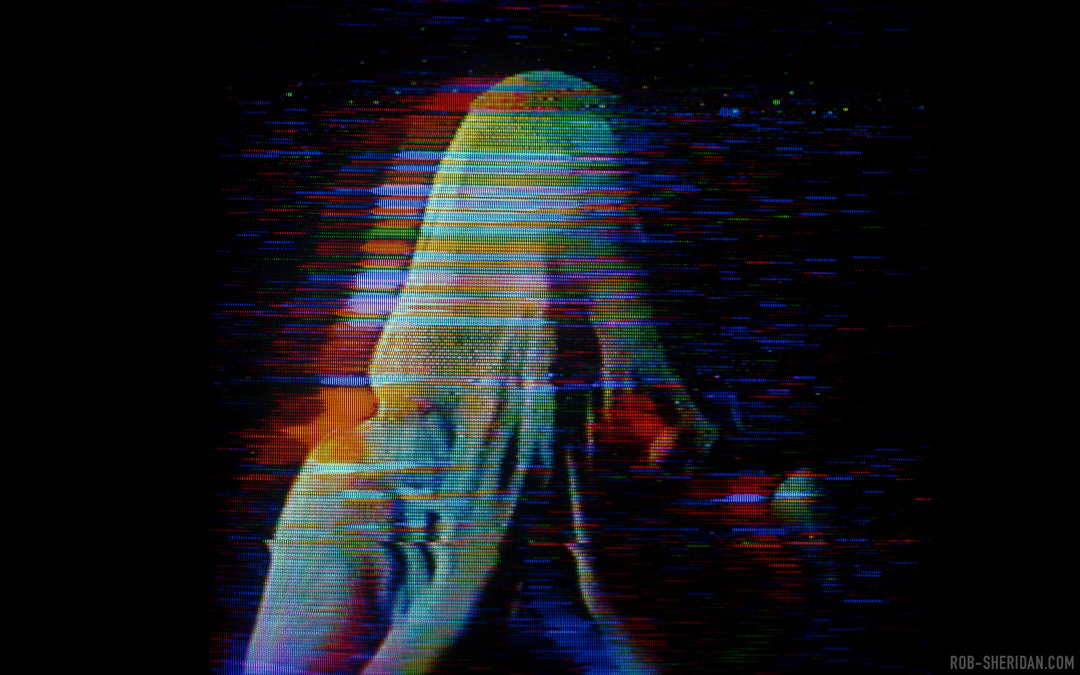Televisions are not only a great place to view horror, but they have also played a key role in a number of scary films over the years from Poltergeist to The Ring. See how an artist has tapped directly into our psyche with some truly chilling imagery created using a series of analog devices to create the effects.
Rob Sheridan has created some of the most unique and visually thematic artwork I have ever seen during his tenure as the former Nine Inch Nails Creative Director. I’m not alone in feeling this way as his work has received a number of accolades including being nominated for two Grammys for special edition package design. Call me a fanboy, but being the one defining the distinct visual identity of Trent Reznor’s musical genius for over 15 years would rank above almost anything you could tell me about someone.
Sheridan has been refining his custom analog glitch process for over five years now. The exact steps have evolved and expanded as he has experimented with different techniques. The current gold standard involves recording the imagery on purposely damaged VHS tapes through old VCRs. The VCRs are hooked into old CRT televisions.
The magic then comes in the form of disrupting the pure signal in different ways and capturing the results in with a digital camera using high-speed burst mode. Subtle warping and glitching can be cherry-picked frame by frame when reviewing the shots. Moments of the images being torn apart are often missed by the naked eye can result in some of the most appealing creations.
The entire analog glitch series as a whole is rooted in a sense of paranoia and dread. This year, however, Sheridan took it a step further by focusing on horror-themed glitch prints.
Having grown up in the 80s and 90s, the overall aesthetic of weathered VHS tapes with bad tracking and glowing CRT televisions is deeply intertwined in our memories. We have all stared at the screen for too long or gotten so close that the image turned into tiny dots of color. The loss of quality from dubbing tape to tape, interference, video-noise, and color bleeds are all reminders of the overall texture of horror for those of us who grew up during the VHS era.
The fact that these effects are done in-camera(s) is as impressive as the final results themselves. With Adobe Photoshop so readily available and prevalent these days, it's great to see someone put in the work and truly follow their passion in the name of art.
While watching horror flicks, turning our eyes away from the glow often adds to the darkness around us and can send scary thoughts through our heads. It is there that Sheridan’s horror glitch series truly lives. Conjuring analog nightmares of fear held deep in our cultural subconscious. There was a limited edition print sale running through Halloween. The sale is being extended through November 5th for our readers. Use "fstoppers" as a promo code for 20% off. If you order a print, make sure to hang it in the dark shadows where it belongs.
All images used with permission by Rob Sheridan.












I worked on a fictional project for someone some time back that created the look of a "found" VHS tape with "interviews" of people talking about a central character in the story. Originally I was going to fake the analog look in post, but started looking around for an old analog VHS-C camera to shoot it on instead. I could not find a suitable camera, but I still had my old Sony TRV-900 MiniDV camera stuffed away in a closet, so I shot it with that and dumped the analog output from the Sony into a VHS recorder set at it's lowest quality recording setting. I then knocked the playback tracking slightly off and digitized the footage. Worked like a charm.
Sounds awesome. This makes me want to start digging through the archives of gear and see what still works to play with.